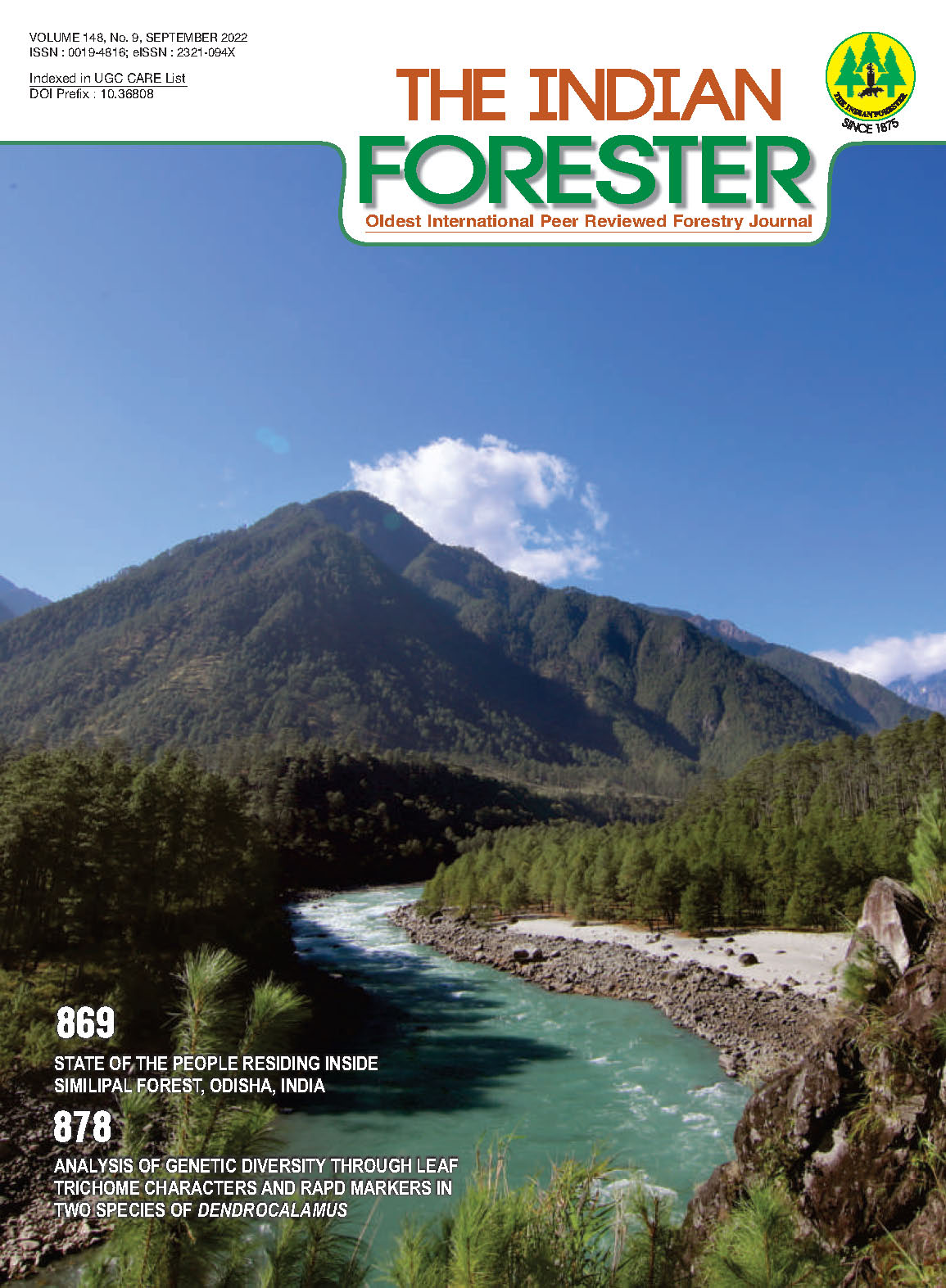Nutritional Assessment of a Traditionally Important Shrub Haloxylon Salicornicum from Four different Locations of Western Rajasthan
DOI:
https://doi.org/10.36808/if/2022/v148i9/165705Keywords:
Nutritional, Seeds, Elements, Proximate, Supplement, DietaryAbstract
Haloxylon salicornicum is a very important lesser known wild fruiting shrubspecies of arid region. It has edible seeds and reported to be used for bread
making by mixing with other grains during famines. Fruits and seeds are also
used as animal feed, wood as fuel and different plant parts for medicine
purpose. It is a good soil binder hence used in restoration of degraded lands.
Nutritional evaluation of Haloxylon salicornicum seeds was carried out from
four different locations of Western Rajasthan. Moisture, ash, sugar, fat, fibre
content were determined using standard AOAC procedures. Seeds were
found to contain protein (12.04-18.3%), sugar (2.63-6.11%), crude fat (1.6-
3.51%) and vitamin C (34.85-47.96 mg/100g). Mineral analysis showed that
they were rich source of Fe, Mn, Mg, K and Ca. This work aims at summarizing
information on the food value of H. salicornicum so as to promote this
species for domestication in arid lands for use as dietary supplement. As it
can survive under extreme drought conditions so can be used for cultivation
in marginal lands of arid areas.
References
Anon. (2013). Hydrogeological Atlas of Rajasthan, Jaisalmer District, Groundwater Department Rajasthan. pp. 1-5.
AOAC. (1984), Association of Official Analytical Chemists. Official methods of analysis of the Association of Official Analytical Chemists. 14 ed. Washington, DC.
Ashraf M.A., Karamat M., Shahnaz K., Abdul W. and Ismail Y. (2012). Study of chemical and mineral constituents of Haloxylon salicornicum collected from Cholistan Desert, Bahawalpur, Pakistan. Wlfenia Journal, 19(10): 306-327.
Bhandari M.M. (1990). Flora of the Indian Desert. MPS Repros, Jodhpur.
Bibi N., Tanoli S.A.K., Farheen S., Afza N., Siddiqi S., Zhang Y., Kazmi S.U., Malik A. (2010). In vitro antituberculosis activities of the constituents isolated from Haloxylon salicornicum. Bioorg Med Chem Lett., 20: 4173–4176.
Boulos L. (1999). Flora of Egypt, vol. 1, Al-Hadra, Cairo, Egypt.
El-Shazly A.M., Dora G., Wink M. (2005). Alkaloids of Haloxylon salicornicum (Moq.) Bunge ex Boiss. (Chenopodiaceae),” Pharmazie., 60(12): 949-952.
Gibbons S., Denny B.J., Ali-Amine S. (2000). NMR spectroscopy, X-ray crystallographic, and molecular modeling studies on a new pyranone from Haloxylon salicornicum. Journal of Natural Products, 63(6): 839-840.
ICMR, (2010). Nutrient requirements and RDA for Indians- A Report of Expert Group of ICMR. Annexure A &B.
Kaur P. and Bains N.S. (2012). Extraction of flavonoids from in vitro and in vivo tissue culture of some important halophytes of western Rajasthan. Int J Pharm Tech Res., 4(3): 1167–1171.
Mathur B.K., Singh J.P., Rathore V.S., Singh N.P. and Beniwal R.K. (2011). Utilization of hot desert shrub: Lana (Haloxylon salicornicum) seeds as feed resources in arid zone. Indian J Small Ruminants., 17: 231–234.
Rathore V.S., Singh J.P. and Roy M.M. (2011). Shrubs of hot arid Rajasthan: economic and ecological imperatives - a review. Range Management and Agroforestr., 32: 71 – 78.
Rathore V.S., Singh J.P., Bhardwaj S., Nathawat N.S., Kumar M. and Roy M.M. (2015). Potential of native shrubs Haloxylon salicornicum and Calligonum polygonoides for restoration of degraded lands in arid Western Rajasthan, India. Environmental Management, 55: 205–216.
Saleem N.H., Ferro V.A., Simpson A.M., Igoli J., Gray A. and Drummond R.M. (2013). The inhibitory effect of Haloxylon salicornicum on contraction of the mouse uterus. Evidencebased complementary and alternative medicine. 2013: 10.
Shankar V. and Kumar S. (1984). Ecological distribution of H. salicornicum (Moq.) Bunge as an aid to the reconstruction of the lost courses of the Sarswati River in the Indian Desert. Trop. Ecol., 25: 227–238.
Singh J.P., Rathore V.S. and. Roy M.M. (2015). Notes about Haloxylon salicornicum (Moq.) Bunge ex Boiss., a promising shrub for arid regions. Genet Resour Crop Evol., 62: 451–463.
Ullah R., Alsaid, Mansour S., Alqahtani, Ali S., Shahat, Abdelaaty A., Naser, Almoqbil A., Mahmood, Majid H., Ahamad, Rizwan S., Al-Mishari, Abdullah A. and Ahmad S. (2019). Antiinflammatory, antipyretic, analgesic, and antioxidant activities of Haloxylon salicornicum aqueous fraction. Open Chemistry, 17(1): 1034-1042.
Downloads
Downloads
Additional Files
Published
How to Cite
Issue
Section
License
Unless otherwise stated, copyright or similar rights in all materials presented on the site, including graphical images, are owned by Indian Forester.





